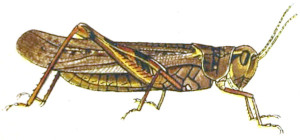...the clouds of grasshoppers. According to Lieutenant Warren, whose graphic description is here borrowed, these insects are “nearly the same as the locusts of Egypt; and no one who has not traveled on the prairie, and seen for himself, can appreciate the magnitude of the swarms. Often they fill the air for many miles of extent, so that an inexperienced eye can scarcely distinguish their appearance from that of a shower of rain or the smoke of a prairie fire. The height of their flight may be somewhat appreciated, as Mr. E. James saw them above his head, as far as their size would render them visible, while standing on the top of a peak of the Rocky Mountains, 8500 feet above the plain, and an elevation of 14,500 above that of the sea, in the region where the snow lies all the year. To a person standing in one of these swarms as they pass over and around him, the air becomes sensibly darkened, and the sound produced by their wings resembles that of the passage of a train of cars on a railroad when standing two or three hundred yards from the track. The Mormon settlements have suffered more from the ravages of these insects than probably all other causes combined. They destroyed nearly all the vegetables cultivated last year at Fort Randall, and extended their ravages east as far as Iowa.

The Rocky Mountain locust (Melanoplus spretus) is an extinct species of grasshopper that ranged through the western half of the United States and some western portions of Canada with large numbers seen until the end of the 19th century. Sightings often placed their swarms in numbers far larger than any other locust species, with one famous sighting in 1875 estimated at 198,000 square miles (510,000 km2) in size (greater than the area of California), weighing 27.5 million tons and consisting of some 12.5 trillion insects, the greatest concentration of animals ever speculatively guessed, according to Guinness World Records.